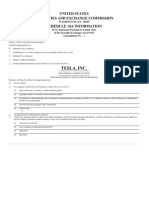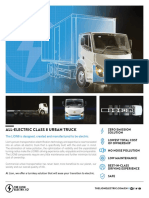Page
2
of
2
The Tesla struck the left side of the semitrailer. The roof of the Tesla was sheared off as the vehicle underrode the semitrailer and continued south (figure 2). The Tesla came to a rest on the median, about 1,600 feet from where it struck the semitrailer. The 50-year-old male Tesla driver died as a result of the crash. The 45-year-old male driver of the combination vehicle was uninjured.
Figure 2.
Tesla Model 3 with extensive roof damage photographed postcrash at tow yard.
Preliminary data from the vehicle show that the Tesla’s Autopilot system—an advanced driver assistance system (ADAS) that provides both longitudinal and lateral control over vehicle motion—was active at the time of the crash.
The driver engaged the Autopilot about 10 seconds before the collision. From less than 8 seconds before the crash to the time of impact, the vehicle did not detect the driver’s hands on the steering wheel. Preliminary vehicle data show that the Tesla was traveling about 68 mph when it struck the semitrailer. Neither the preliminary data nor the videos indicate that the driver or the ADAS executed evasive maneuvers. The National Transportation Safety Board (NTSB) continues to gather information on the operation of the Tesla’s ADAS and the Tesla driver’s actions leading up to the crash. The investigation will also examine the driver of the combination vehicle, the motor carrier, highway factors, and survival factors. All aspects of the crash remain under investigation as the NTSB determines the probable cause, with the intent of issuing safety recommendations to prevent similar crashes. The NTSB is working in partnership with the Palm Beach County Sheriff’s Office during the investigation.
1
Autopilot is a proprietary name used by Tesla for a combination of vehicle automation systems that provide driver assistance through the Traffic-Aware Cruise Control, Autosteer, and Auto Lane Change systems. According to Tesla, Autosteer uses camera sensors, radar, and ultrasonic sensors to determine how to steer the vehicle, and it requires drivers to hold the steering wheel—an alert is given to the driver if the system does not detect a driver hand on the steering wheel for a period of time.
 Fred Lamert
Fred Lamert Graham
Graham Fred Lamert
Fred Lamert Fred Lamert
Fred Lamert Fred Lamert
Fred Lamert CCN
CCN Fred Lamert
Fred Lamert Fred Lamert
Fred Lamert Fred Lamert
Fred Lamert Fred Lamert
Fred Lamert Fred Lamert
Fred Lamert Fred Lamert
Fred Lamert Fred Lamert
Fred Lamert Zerohedge
Zerohedge Fred Lamert
Fred Lamert Fred Lamert
Fred Lamert Fred Lamert
Fred Lamert Fred Lamert
Fred Lamert Fred Lamert
Fred Lamert Fred Lamert
Fred Lamert Fred Lamert
Fred Lamert Fred Lamert
Fred Lamert Fred Lamert
Fred Lamert Fred Lamert
Fred Lamert Fred Lamert
Fred Lamert Fred Lamert
Fred Lamert Fred Lamert
Fred Lamert Fred Lamert
Fred Lamert Fred Lamert
Fred Lamert Fred Lamert
Fred Lamert



























